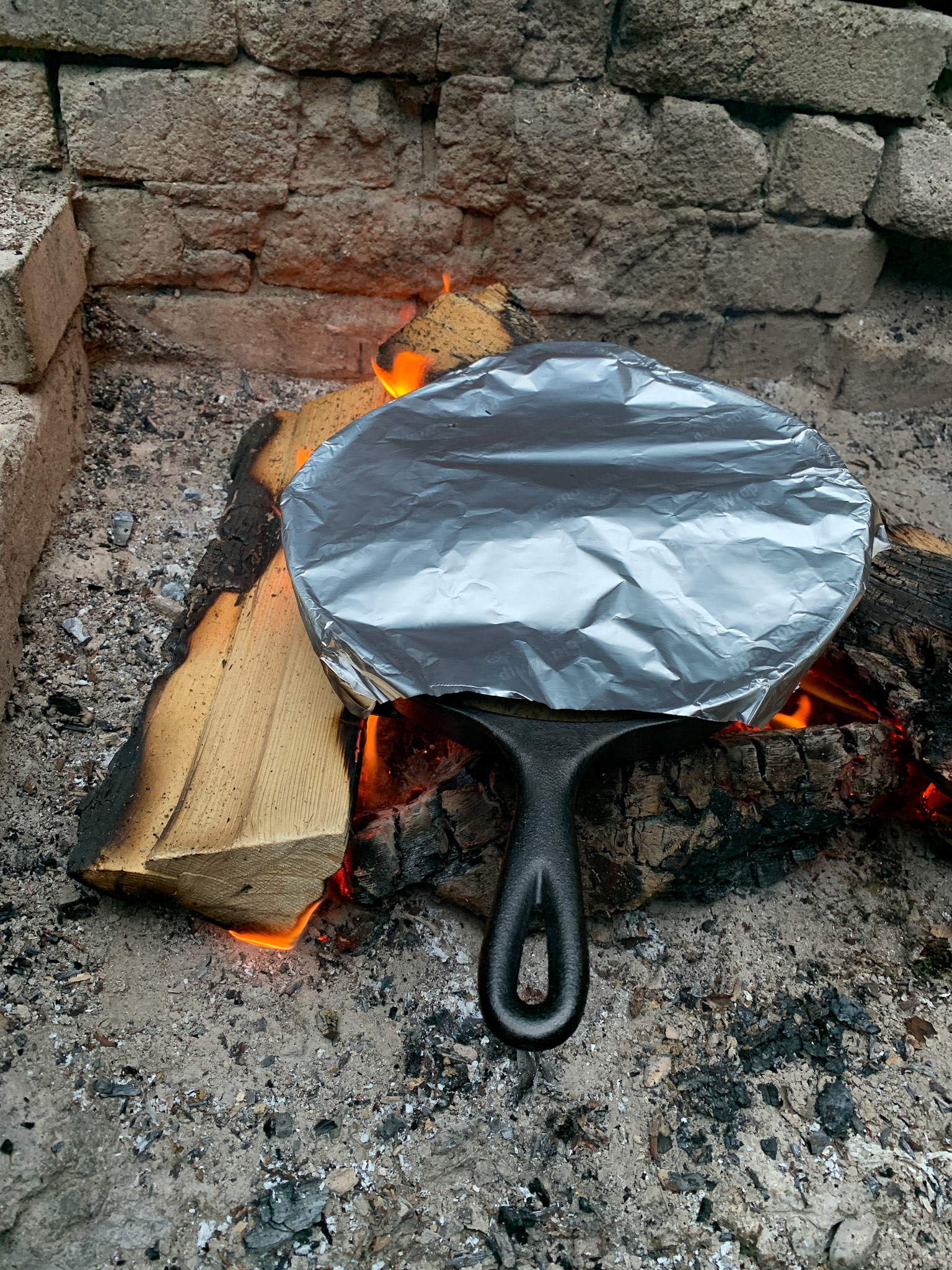Some food just tastes better outside, and here at Junction, we’ve found ourselves hiking and camping more than ever as a way to responsibly see friends and family—and the chilly nights and mornings haven’t scared us off yet. Whether or not camping is your thing, so many of us have found comfort in rituals and traditions—old or new—as the pandemic has worn on, and so we’ve compiled some of our tried and true alfresco meals to share with you this week.
Photo by Isaac Lorton
The Perfect Hiking Sandwich
I had this sandwich for the first time on a nature writing retreat with a beloved high school English teacher. Mrs. S. confidently walked us through our first readings of Moby-Dick and Anna Karenina, laying the groundwork for lifelong relationships with both books. She taught us how to be patient with poetry at first, giving it time and space and just enough attention—the thrill of a houseplant watered by ice chips suddenly blooming. She drove us to a reading by Seamus Heaney, who kindly (I tell myself) interrupted his enjoyment of a large piece of chocolate cake to sign a nervous sixteen year old’s book at the reception. And then—between nature walks and deep dives into Emerson and Thoreau—she showed us how to make the perfect hiking sandwich with the same ceremony with which we’d approached Emily Dickinson.
First, it’s important to consider the structural integrity of your bread so there’s no risk of your lunch endangering whatever book or notebook you’ve also stuffed into your hiking pack: enter the bagel, a game changer. Next, cut outrageously thick slices of the sharpest New England cheddar you can find. Scoop large spoonfuls of old style mustard seeds, and generously spread over both halves of the bagel. Once you’ve arranged the cheddar slices on one side, garnish the cheese with sun-dried tomatoes, marry both halves, and wrap in not one, but two layers of tinfoil.
It’s one of those simple pleasures that somehow loses its magic on an ordinary day—it has to be earned, and it has to be eaten somewhere a little wild. I’ve now made this sandwich in every national park I’ve ever been to as an adult. It’s hardy and sturdy and filling and flavorful, and somehow it always makes me feel like a student again—I slow down, I listen, I look, I remember my teacher’s thin hand with its familiar jade ring as she gestured sagely one morning with a cheese knife instead of a pencil.
- Molly Papows
Photo by Molly Papows
Grilled Eggs
I write this at the risk of sounding like an idiot. This summer, I went camping on Gilman Island with a friend. We packed a canoe with every comfort of home: tents, hammocks, chairs, games, cheese, whiskey, steak tips, and an elderly dachshund named Horatio. When we arrived, we swam in the warm waters of the Connecticut River, made steak and veggie kebabs over a hot fire, and talked well into the night about the strangeness of the moment. The next morning, we rose in desperate need of coffee only to find that I hadn’t packed a single pot or pan for boiling water. We tried using some glass Ball jars—one shattered, the other made us a lukewarm ‘coffee’ and then shattered. We had the fixings for breakfast burritos, but nothing to cook the eggs in.
Earlier in the summer, my CSA box had been overflowing with veggies I didn’t know what to do with, but found most things tasted great on a grill. Curious about the bounds of grilling, I'd even Googled “can u grill eggs?” and saw photos of eggs on a grill. What a world.
Now, in a pinch, we had to try. We placed four eggs on different spots on the grill over the morning fire. We tried rotating them with sticks and our grubby, hungover little fingers. The flames painted smoky patterns on the shells.
We shook the eggs to try to hear if they sounded cooked. When I thought one was done, I cracked it open a bit only to find that it was still soft inside. I placed it back on the grill and watched as the albumen turned opaque. I checked another, it hadn’t been rotated enough and had a gradient of extra hard on one side to sunnyside on the other. As we grew hungrier, we decided to go for it. We cracked the eggs onto our toasted tortillas with avocado, hot sauce and deliciously grilled Campari tomatoes. They had a slight smoky flavor and it was deeply satisfying to cook an egg over a morning fire. I no longer felt ill-prepared but, dare I say, resourceful.
So, in a pinch, yes, u can grill eggs.
- Colleen Goodhue
Photo by Colleen Goodhue
Campfire Nachos
While combing through a book of campfire recipes for a trip earlier this year, I stumbled across a recipe for campfire nachos, an idea so brilliant I was upset I hadn’t come up with it myself.
As with your standard nacho, the premise here is simple—you need a cast iron pan, some tortilla chips, some shredded cheese, and some foil (or a lid) to cover the pan with. Beyond that, what you add is up to you. The recipe I found suggested cooking some meat at home to bring, but you could also cook it in the cast iron and then add it onto the nachos later.
My main tip is to not stack the nachos in layers, just plan to do a couple of rounds instead—if you stack, the bottom layer will get too crispy by the time the cheese on the top layer is melted.
- Taylor K. Long

Photo by Taylor K. Long

Photo by Taylor K. Long
The CSA Surprise
Susan (my partner) and I pick up our CSA share every Friday. This is the first season we’ve ever done a CSA. This is also the first summer Susan has ever camped. The few times we have camped this summer, we have picked up our box on our way to the campsite. Sweetland Farm is great because they give us a forecast of what to expect in our basket the following week and also an email on pick up day with what we’ll actually be getting. The first email: a chance to plan. The second email: the improvisation. Susan puts up with my self-imposed cooking-show rules, knowing that most of the time these meals turn out pretty okay. Most of the time. My interest in cooking on the fly (there’s usually somewhat of a plan) developed through years of eating—later helping to make—my parents’ thrifty meals and from watching late-night episodes of the original Iron Chef.
With this spirit in mind on our most recent camping trip in the Whites, I put together some spice blends and prepared the pending menu Thursday night. Friday, we picked up our CSA box and got some greens, carrots, peppers, onions, turnips, radishes, and a humongous squash—significantly larger than Horatio the Paddle Dog, Junction editor Colleen Goodhue’s dachshund. But no potatoes. Though they were in the forecast, they did not drop that Friday. It was okay, we brought a potato from home. Bending rules a bit, but this was my own silly challenge. I sauteed potatoes, onions, and peppers in an oiled cast iron pan with a smoked paprika seasoning blend, the smell reminiscent of ballpark sausage stands where they grill onions and peppers on the flat top. Accompanied by a hunk of freshly baked bread with butter, we feasted on our CSA surprise camp meal.
- Isaac Lorton
Photo by Isaac Lorton
Toasted Marshmallows
It is simplicity itself, the toasted marshmallow, requiring nothing more than a fire, a stick, and the barest bit of patience to change an ethereal white puff into a scorched and sticky ooze, the latter being the thing you actually want to eat.
This is not about s’mores, mind you, not those one-note, too-sweet sandwiches that are practically the Pavlovian response to the word “campfire.” With their grainy chocolate, cardboard crackers, and awkward fireside assembly, s’mores are a fine way to ruin a perfectly good toasted marshmallow. Nor is this the marshmallow in its raw form, which may be entertainingly squidgy, something fun to pop in the microwave and watch explode, but which boasts of all the flavor and mouthfeel of a flour-dusted sponge. No, like an untested champion, a marshmallow must stand alone and endure its trial by fire to be transformed from commonplace to extraordinary.
Carefully pyrolyzed over a steady flame, the ideal toasted marshmallow boasts a bubbly brown shell, the crackled coating of barely burnt sugar bittersweet and chewy. Beneath it, a core of luscious molten goo is ready to either be eaten as-is, smooshed between slabs of Hershey’s and graham crackers if you must, or, and this is the beautiful part, put back over the fire and re-caramelized to replace the warm, candied skin that’s just been peeled away and consumed. Heat, eat, repeat. Get the hang of it and one marshmallow goes a surprisingly long way, which is just as well—manufactured from dubious components and alarmingly shelf-stable, marshmallows, like so many of the best things in life, should probably be enjoyed sparingly, if luxuriantly.
- Hazel-Dawn Dumpert
Photo by Hazel-Dawn Dumpert
Ghirardelli Dark Chocolate Squares S’mores
When I want to make an indulgent twist on the already-perfect dessert of campfire s’mores, I’ll substitute in either a sea salt, caramel dark chocolate square (which pairs well with a cinnamon graham cracker) or a raspberry dark chocolate square. And they’re individually wrapped, which can be good in these times when breaking off a piece with your soot-covered hands and passing it to the other person is probably less charming than usual.
- Isaac Lorton
Photo by Taylor K. Long
Reese’s Peanut Butter Cup S’mores
Not exactly a recipe, but my all-time favorite twist on a classic—replace the Hershey bar in your s’more with a Reese’s Peanut Butter Cup. They now make the “thins,” which are basically designed with this in mind.
- Taylor K. Long
Photo by Taylor K. Long
October 2020
Hazel-Dawn Dumpert lives and writes in West Lebanon, NH.
Colleen Goodhue is an Upper Valley enthusiast. Formerly of West Lebanon, she is a videomaker and writer living in South Hadley, MA.
Taylor K. Long is a writer, editor, and photographer based in Windsor, VT. Her work has appeared in The New York Times, The New York Press, New York Magazine, Bright Wall/Dark Room and more.
Isaac Lorton is thrilled to be writing, editing, and photographing in the Twin State region. Simply, Isaac is happy to be here in this place at this moment with this group of people.
Molly Papows is an art historian based in Lebanon, NH. She has an MA in the History of Art and Architecture from Boston University and ten years of experience working in encyclopedic fine art museums. She's also interested in the many ways an artist can tell a story across disciplines — from fiction and nonfiction to poetry, landscape architecture, and music.
